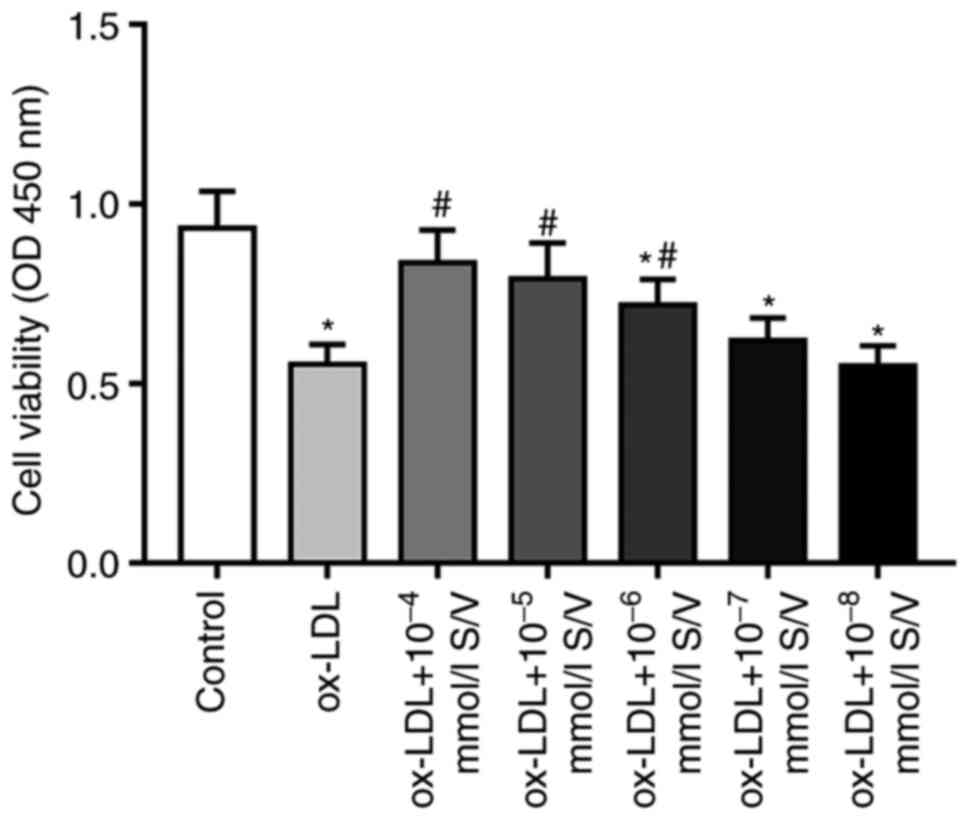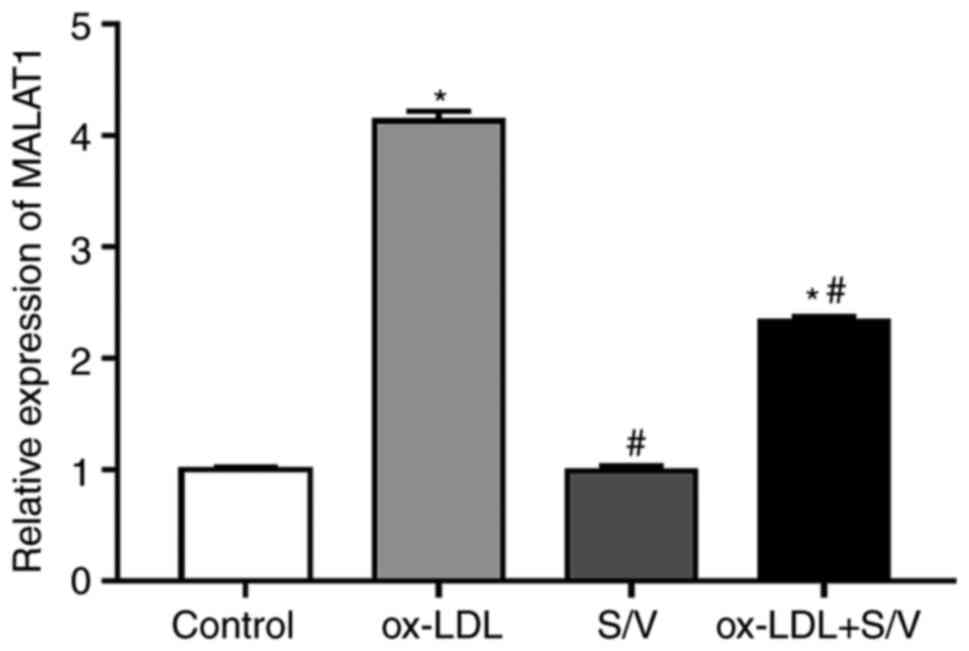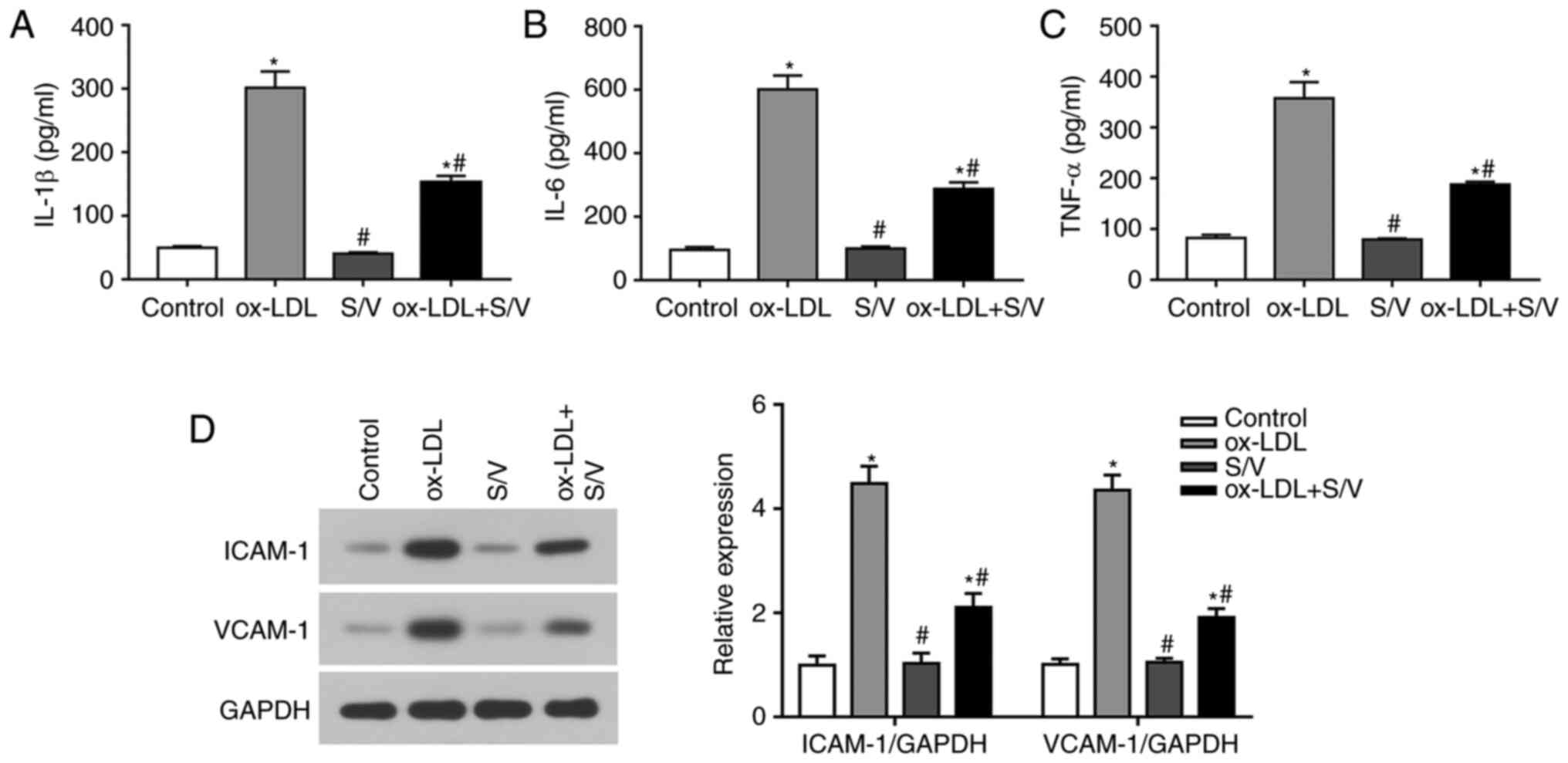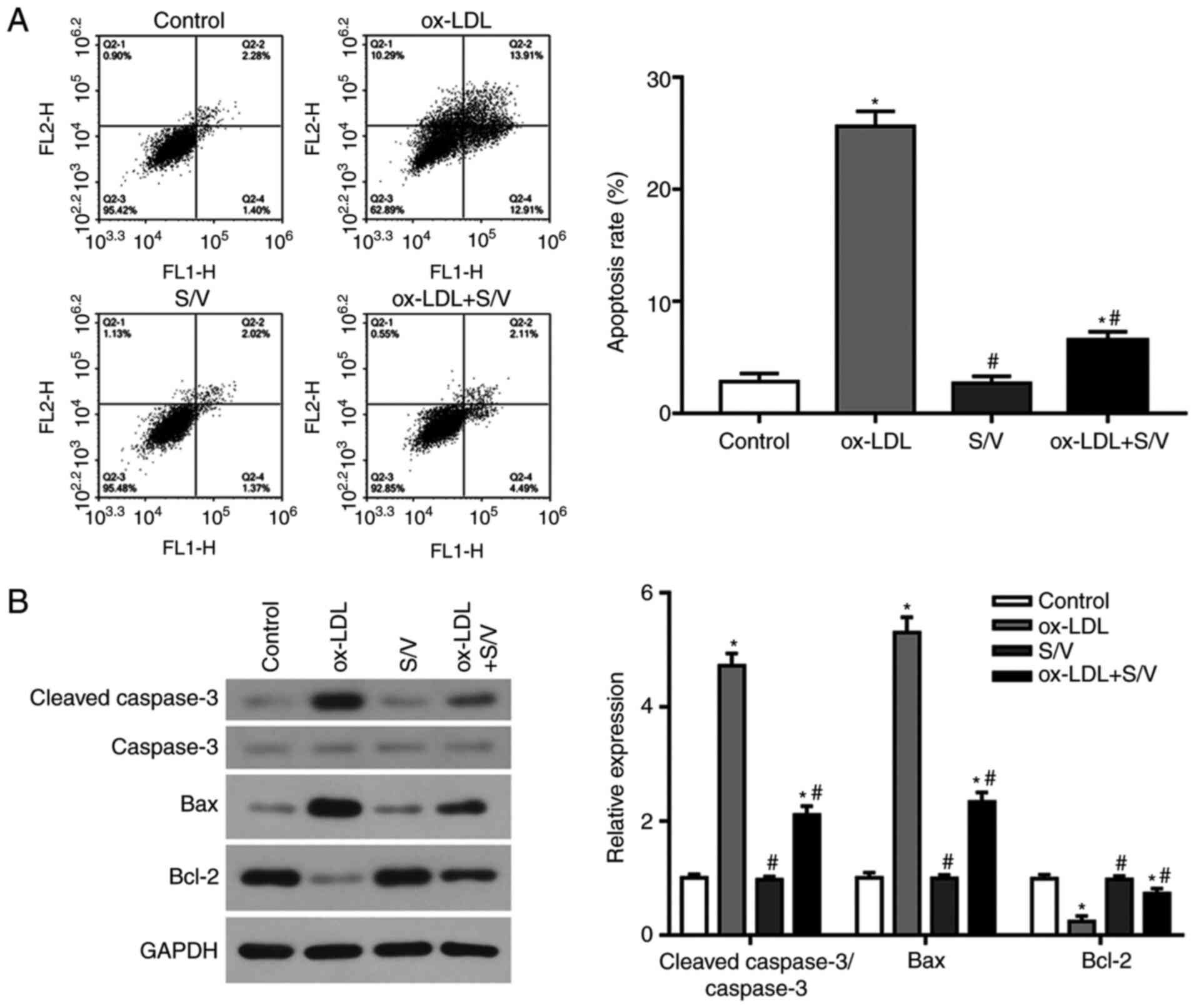|
1
|
Mendis S, Davis S and Norrving B:
Organizational update: the world health organization global status
report on noncommunicable diseases 2014; one more landmark step in
the combat against stroke and vascular disease. Stroke.
46:e121–122. 2015. View Article : Google Scholar : PubMed/NCBI
|
|
2
|
Hansson GK: Inflammatory mechanisms in
atherosclerosis. J Thromb Haemost. 7 (Suppl 1):S328–S331. 2009.
View Article : Google Scholar
|
|
3
|
Moore KJ and Tabas I: Macrophages in the
pathogenesis of atherosclerosis. Cell. 145:341–355. 2011.
View Article : Google Scholar : PubMed/NCBI
|
|
4
|
Förstermann U, Xia N and Li H: Roles of
vascular oxidative stress and nitric oxide in the pathogenesis of
atherosclerosis. Circ Res. 120:713–735. 2017. View Article : Google Scholar : PubMed/NCBI
|
|
5
|
Gimbrone MA and García-Cardeña G:
Endothelial cell dysfunction and the pathobiology of
atherosclerosis. Circ Res. 118:620–636. 2016. View Article : Google Scholar : PubMed/NCBI
|
|
6
|
Han QA, Yan C, Wang L, Li G, Xu Y and Xia
X: Urolithin A attenuates ox-LDL-induced endothelial dysfunction
partly by modulating microRNA-27 and ERK/PPAR-γ pathway. Mol Nutr
Food Res. 60:1933–1943. 2016. View Article : Google Scholar : PubMed/NCBI
|
|
7
|
Fan X, Wang J, Hou J, Lin C, Bensoussan A,
Chang D, Liu J and Wang B: Berberine alleviates ox-LDL induced
inflammatory factors by up-regulation of autophagy via AMPK/mTOR
signaling pathway. J Transl Med. 13:922015. View Article : Google Scholar : PubMed/NCBI
|
|
8
|
Mercer TR, Dinger ME and Mattick JS: Long
non-coding RNAs: Insights into functions. Nat Rev Genet.
10:155–159. 2009. View
Article : Google Scholar : PubMed/NCBI
|
|
9
|
Boon RA, Jaé N, Holdt L and Dimmeler S:
Long noncoding RNAs: From clinical genetics to therapeutic targets.
J Am Coll Cardiol. 67:1214–1226. 2016. View Article : Google Scholar : PubMed/NCBI
|
|
10
|
Tano K, Mizuno R, Okada T, Rakwal R,
Shibato J, Masuo Y, Ijiri K and Akimitsu N: MALAT-1 enhances cell
motility of lung adenocarcinoma cells by influencing the expression
of motility-related genes. FEBS Lett. 584:4575–4580. 2010.
View Article : Google Scholar : PubMed/NCBI
|
|
11
|
Wang K, Yang C, Shi J and Gao T:
Ox-LDL-induced lncRNA MALAT1 promotes autophagy in human umbilical
vein endothelial cells by sponging miR-216a-5p and regulating
Beclin-1 expression. Eur J Pharmacol. 858:1723382019. View Article : Google Scholar : PubMed/NCBI
|
|
12
|
Tang Y, Jin X, Xiang Y, Chen Y, Shen CX,
Zhang YC and Li YG: The lncRNA MALAT1 protects the endothelium
against ox-LDL-induced dysfunction via upregulating the expression
of the miR-22-3p target genes CXCR2 and AKT. FEBS Lett.
589:3189–3196. 2015. View Article : Google Scholar : PubMed/NCBI
|
|
13
|
Gu J, Noe A, Chandra P, Al-Fayoumi S,
Ligueros-Saylan M, Sarangapani R, Maahs S, Ksander G, Rigel DF,
Jeng AY, et al: Pharmacokinetics and pharmacodynamics of LCZ696, a
novel dual-acting angiotensin receptor-neprilysin inhibitor (ARNi).
J Clin Pharmacol. 50:401–414. 2010. View Article : Google Scholar : PubMed/NCBI
|
|
14
|
McMurray JJ, Packer M, Desai AS, Gong J,
Lefkowitz MP, Rizkala AR, Rouleau JL, Shi VC, Solomon SD, Swedberg
K, et al: Angiotensin-neprilysin inhibition versus enalapril in
heart failure. N Engl J Med. 371:993–1004. 2014. View Article : Google Scholar : PubMed/NCBI
|
|
15
|
Pagliaro BR, Cannata F, Stefanini GG and
Bolognese L: Myocardial ischemia and coronary disease in heart
failure. Heart Fail Rev. 25:53–65. 2020. View Article : Google Scholar : PubMed/NCBI
|
|
16
|
Livak KJ and Schmittgen TD: Analysis of
relative gene expression data using real-time quantitative PCR and
the 2(-Delta Delta C(T)) method. Methods. 25:402–408. 2001.
View Article : Google Scholar : PubMed/NCBI
|
|
17
|
Cheng J, Liu Q, Hu N, Zheng F, Zhang X, Ni
Y and Liu J: Downregulation of hsa_circ_0068087 ameliorates
TLR4/NF-κB/NLRP3 inflammasome-mediated inflammation and endothelial
cell dysfunction in high glucose conditioned by sponging miR-197.
Gene. 709:1–7. 2019. View Article : Google Scholar : PubMed/NCBI
|
|
18
|
Wan CX, Xu M, Huang SH, Wu QQ, Yuan Y,
Deng W and Tang QZ: Baicalein protects against endothelial cell
injury by inhibiting the TLR4/NF-κB signaling pathway. Mol Med Rep.
17:3085–3091. 2018.PubMed/NCBI
|
|
19
|
Proudfoot C, Studer R, Rajput T, Jindal R,
Agrawal R, Corda S and Senni M: Real-world effectiveness and safety
of sacubitril/valsartan in heart failure: A systematic review. Int
J Cardiol. Feb 3–2021.(Epub ahead of print). View Article : Google Scholar : PubMed/NCBI
|
|
20
|
Ruilope LM, Dukat A, Böhm M, Lacourcière
Y, Gong J and Lefkowitz MP: Blood-pressure reduction with LCZ696, a
novel dual-acting inhibitor of the angiotensin II receptor and
neprilysin: A randomised, double-blind, placebo-controlled, active
comparator study. Lancet. 375:1255–1266. 2010. View Article : Google Scholar : PubMed/NCBI
|
|
21
|
Seferovic JP, Claggett B, Seidelmann SB,
Seely EW, Packer M, Zile MR, Rouleau JL, Swedberg K, Lefkowitz M,
Shi VC, et al: Effect of sacubitril/valsartan versus enalapril on
glycaemic control in patients with heart failure and diabetes: A
post-hoc analysis from the PARADIGM-HF trial. Lancet Diabetes
Endocrinol. 5:333–340. 2017. View Article : Google Scholar : PubMed/NCBI
|
|
22
|
Seki T, Goto K, Kansui Y, Ohtsubo T,
Matsumura K and Kitazono T: Angiotensin II receptor-neprilysin
inhibitor sacubitril/valsartan improves endothelial dysfunction in
spontaneously hypertensive rats. J Am Heart Assoc. 6:e0066172017.
View Article : Google Scholar : PubMed/NCBI
|
|
23
|
Kido K, Bianco C, Caccamo M, Fang W and
Sokos G: Evaluating sacubitril/valsartan dose dependence on
clinical outcomes in patients with heart failure with reduced
ejection fraction. Ann Pharmacother. Dec 31–2020.(Epub ahead of
print). View Article : Google Scholar
|
|
24
|
Zhu L, Gong X, Gong J, Xuan Y, Fu T, Ni S,
Xu L and Ji N: Notoginsenoside R1 upregulates miR-221-3p expression
to alleviate ox-LDL-induced apoptosis, inflammation, and oxidative
stress by inhibiting the TLR4/NF-κB pathway in HUVECs. Braz J Med
Biol Res. 53:e93462020. View Article : Google Scholar : PubMed/NCBI
|
|
25
|
Li W, Li Y, Zhao Y and Ren L: The
protective effects of aloperine against ox-LDL-induced endothelial
dysfunction and inflammation in HUVECs. Artif Cells Nanomed
Biotechnol. 48:107–115. 2020. View Article : Google Scholar : PubMed/NCBI
|
|
26
|
García de Tena J: Inflammation,
atherosclerosis, and coronary artery disease. N Engl J Med.
353:429–430. 2005. View Article : Google Scholar
|
|
27
|
Yang X, Wan M, Cheng Z, Wang Z and Wu Q:
Tofacitinib inhibits ox-LDL-induced adhesion of THP-1 monocytes to
endothelial cells. Artif Cells Nanomed Biotechnol. 47:2775–2782.
2019. View Article : Google Scholar : PubMed/NCBI
|
|
28
|
Feng C, Chen Q, Fan M, Guo J, Liu Y, Ji T,
Zhu J and Zhao X: Platelet-derived microparticles promote
phagocytosis of oxidized low-density lipoprotein by macrophages,
potentially enhancing foam cell formation. Ann Transl Med.
7:4772019. View Article : Google Scholar : PubMed/NCBI
|
|
29
|
Choy JC, Granville DJ, Hunt DW and McManus
BM: Endothelial cell apoptosis: Biochemical characteristics and
potential implications for atherosclerosis. J Mol Cell Cardiol.
33:1673–1690. 2001. View Article : Google Scholar : PubMed/NCBI
|
|
30
|
Qin C and Liu Z: In atherogenesis, the
apoptosis of endothelial cell itself could directly induce
over-proliferation of smooth muscle cells. Med Hypotheses.
68:275–277. 2007. View Article : Google Scholar : PubMed/NCBI
|
|
31
|
Zhang Y, Wang L, Xu J, Kong X and Zou L:
Up-regulated miR-106b inhibits ox-LDL-induced endothelial cell
apoptosis in atherosclerosis. Braz J Med Biol Res. 53:e89602020.
View Article : Google Scholar : PubMed/NCBI
|
|
32
|
Moncada S and Higgs EA: The discovery of
nitric oxide and its role in vascular biology. Br J Pharmacol. 147
(Suppl 1):S193–S201. 2006. View Article : Google Scholar : PubMed/NCBI
|
|
33
|
Bourque SL, Davidge ST and Adams MA: The
interaction between endothelin-1 and nitric oxide in the
vasculature: New perspectives. Am J Physiol Regul Integr Comp
Physiol. 300:R1288–R1295. 2011. View Article : Google Scholar : PubMed/NCBI
|
|
34
|
Penna C, Rastaldo R, Mancardi D, Cappello
S, Pagliaro P, Westerhof N and Losano G: Effect of endothelins on
the cardiovascular system. J Cardiovasc Med (Hagerstown).
7:645–652. 2006. View Article : Google Scholar : PubMed/NCBI
|
|
35
|
Moghimpour Bijani F, Vallejo JG and Rezaei
N: Toll-like receptor signaling pathways in cardiovascular
diseases: Challenges and opportunities. Int Rev Immunol.
31:379–395. 2012. View Article : Google Scholar : PubMed/NCBI
|
|
36
|
Zhao L, Li M, Sun K, Su S, Geng T and Sun
H: Hippophae rhamnoides polysaccharides protect IPEC-J2 cells from
LPS-induced inflammation, apoptosis and barrier dysfunction in
vitro via inhibiting TLR4/NF-κB signaling pathway. Int J Biol
Macromol. 155:1202–1215. 2020. View Article : Google Scholar : PubMed/NCBI
|
|
37
|
Zhang G and Ghosh S: Toll-like
receptor-mediated NF-kappaB activation: A phylogenetically
conserved paradigm in innate immunity. J Clin Invest. 107:13–19.
2001. View Article : Google Scholar : PubMed/NCBI
|
|
38
|
Zhang M, Xue Y, Chen H, Meng L, Chen B,
Gong H, Zhao Y and Qi R: Resveratrol Inhibits MMP3 and MMP9
Expression and Secretion by Suppressing TLR4/NF-κB/STAT3 Activation
in Ox-LDL-Treated HUVECs. Oxid Med Cell Longev.
2019:90131692019.PubMed/NCBI
|
|
39
|
Yu XH, Zheng XL and Tang CK: Nuclear
Factor-κB activation as a pathological mechanism of lipid
metabolism and atherosclerosis. Adv Clin Chem. 70:1–30. 2015.
View Article : Google Scholar : PubMed/NCBI
|
|
40
|
Zhong X, Zhang L, Li Y, Li P, Li J and
Cheng G: Kaempferol alleviates ox-LDL-induced apoptosis by
up-regulation of miR-26a-5p via inhibiting TLR4/NF-κB pathway in
human endothelial cells. Biomed Pharmacother. 108:1783–1789. 2018.
View Article : Google Scholar : PubMed/NCBI
|




















